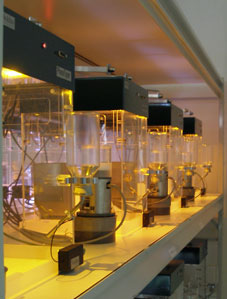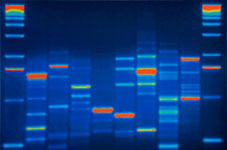

The major long-term goal of the consortium is to
improve the management and treatment of brain disorders by identifying
and phenotyping mouse models that can be used to develop therapies
for such diseases. To reach this goal two major specific aims have
to be fulfilled. First, we have to de-velop and implement novel, automated
yet intelligent HTP screening technology that allows us to select
a single relevant mutant from a collection of thousands; and second,
we have to set up a systemic set of LTP screening arrays that allows
us to precisely determine the neuropathological phenotype of a selected
mouse model at the cellular, microcircuitry and systems level for
all four major areas in neuroscience including sensory, motor, cognitive
and autonomic systems. Once we have realized these two aims we will
subsequently have to standardize the digital analyses and data descriptions
of all screens at all levels and communicate the acquired knowledge
to academic institutions and commercial customers in terms of both
data distribution of phenotype descriptions and of development of
techniques and methods. If all these aims are fulfilled, the present
consortium may well be able to set the international standard for
phenotyping mouse models for brain diseases.
Key objectives
To build a Dutch knowledge platform on mouse phenomics with the aims
described under point 2, two series of key objectives will have to
be addressed. One category deals with technical and methodological
issues, while the other one deals with the scientific outcomes.
I. Technical key objectives:
- To determine to what extent the novel video home cage analysis of
mouse behaviour improves standardized HTP methods that use serial
batteries of fragmented behavioural screen tests.
- To scale up bioassays that are currently being applied at LTP level
to a higher capacity.
- To determine which LTP screen methods have to be added to our array
to identify and elucidate new pathological mechanisms of brain disorders.
II. Scientific key objectives:
- To determine the phenotypes of mouse models for human brain disorders
with single gene defects.
- To determine the phenotypes of mouse models for human brain disorders
with multiple gene defects.
- To determine which part of the respective phenotypes reflects a
direct effect of the genetic defect and which part is due to secondary
compensatory mechanisms.
- To determine which parts of the mouse phenomic map are specific,
and which ones are aspecific.
Measurable (economic-societal) deliverables
of the project
1. Public Health deliverables
I. new animal models for human brain diseases
II. new patented standardized and non-stratified screening technology
for mammalian behaviour
III. new patented screening technologies to develop and test drugs
for neuronal function and brain diseases
IV. new avenues to use animal behaviour for food and drug applications
in general
V. optimisation of the expensive and inefficient preclinical phase
in pharmaceutical in-dustry
2. Economic deliverables
I. animal models for drug development made available to pharmaceutical
companies and drug-validation screening for these companies (several
Dutch industry partners can be discerned already)
II. screenings for third parties in a joint venture of academia and
industry
III. screening procedures, software algorithms and hardware for the
life sciences (through Noldus) with the realistic claim of being better,
cheaper and faster than the existing technologies
IV. technical, organizational, and logistical knowledge about the
operation of a large-scale high-throughput mouse screening facility
(through partner, Harlan)
V. cell and neuronal network analysis procedures for the life sciences
(through collabora-tions with Till Photonics, Cairn, and P.A.L.M.
technologies)
VI. Founding of new screening Neuro-Bsik facility based on the current
consortium that will handle HTP mouse screens for third parties on
a commercial basis after the four years funding term. This company
will continue to identify breed and distribute avail-able mouse lines
with neurological/psychiatric phenotypes.
3. Knowledge diffusion
I. All IP will be patented
II. New insights into the mechanisms underlying human and mouse behaviour
that will be shared with the international neuroscience community
through publications in the best peer-reviewed journals, lectures
and symposia, e.g. the biennial international confer-ence Measuring
Behavior
III. Training of new researchers in a partially combined new top-master
curriculum for (medical) biology, medicine and psychology students
of the two participating univer-sities.
IV. Experience with implemented new technology that will be shared
with manufacturers
V. Information of the general public on new avenues in drug testing
4. Animal welfare
The protocols presently used for mouse phenotyping require many animals,
unnatural testing conditions, unnecessary burden on the animal and
frequent contact between the animal and the experimentator. The new
protocol is mouse-friendly, does not involve physical restrictions
to the animal and can be completed within a few days. Thus, ani-mal
welfare is enhanced, while animal use is diminished.



